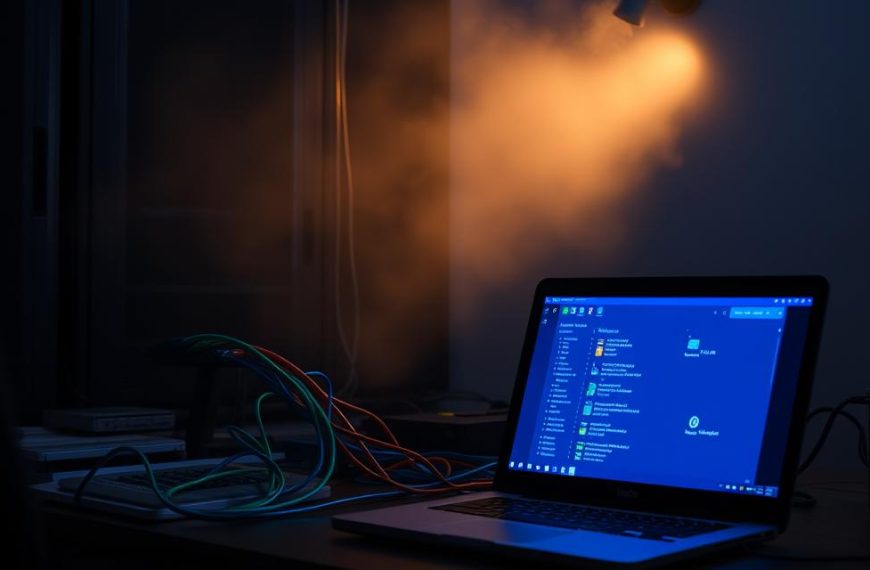Accessing another computer on your network can be incredibly useful, whether you’re working from home or need to retrieve files from a different machine.
The concept of remote desktop technology allows users to control and interact with a computer remotely, providing access to files, applications, and resources as if they were physically present.
Understanding the various methods to achieve this can help you choose the best solution for your needs, ensuring that you can work efficiently and effectively across your network.
This guide will explore the different options available, including built-in Windows tools and third-party applications, to facilitate remote access while maintaining network security.
Understanding Remote Computer Access
Understanding remote computer access is crucial in today’s digitally connected world. Remote desktop technology allows users to control and interact with a computer in another location as if they were physically present.
What is Remote Desktop Technology?
Remote desktop technology enables users to control a computer from a different location, creating a virtual connection that transmits screen output, keyboard inputs, and mouse movements between devices. For more information on connecting two computers, you can visit this resource.
Benefits of Accessing Computers Remotely
Remote desktop access provides numerous benefits, including the ability to access files and applications on your work computer while at home, provide technical support to other users, and manage multiple systems from a single location, all while maintaining a focus on security.
Common Use Cases for Network Computer Access
Common use cases include IT professionals providing remote support, employees accessing work resources from home, and system administrators managing multiple servers without physical presence. When selecting remote desktop software, it’s essential to consider factors such as security features, performance capabilities, and compatibility with your existing systems.
Prerequisites for Network Computer Access
Several key prerequisites must be in place before you can successfully access another computer on your network. Ensuring these conditions are met will facilitate a smooth and secure remote connection.
Ensuring Both Computers Are on the Same Network
To access another computer, both devices must be connected to the same network, either through Wi-Fi or Ethernet. This is a fundamental requirement for establishing a remote connection.
Required Permissions and Settings
The host computer must have remote desktop functionality enabled through its system settings. The specific steps to enable this vary depending on the operating system being used. Additionally, firewall settings on both computers may need to be adjusted to allow remote desktop connections.
| Operating System | Steps to Enable Remote Desktop |
|---|---|
| Windows | Go to Settings > System > Remote Desktop, and toggle the switch to ‘On’. |
| macOS | Open System Preferences > Sharing, and check the box next to ‘Remote Management’. |
Account Credentials and Security Considerations
You’ll need appropriate permissions and account credentials to access the remote computer, typically requiring administrator-level access or specific user accounts with remote access privileges. Security considerations are paramount, including strong password protection and potentially enabling additional authentication methods to safeguard against unauthorized access.
By ensuring that these prerequisites are met, you can establish a secure and reliable remote connection to another computer on your network.
How Do I Access Another Computer on My Network Using Windows Remote Desktop?
To access another computer on your network, you can utilise the Windows Remote Desktop feature, which allows for efficient remote connections. This process involves several key steps to ensure a secure and reliable connection.
Enabling Remote Desktop on the Host Computer
The first step is to enable Remote Desktop on the host computer. To do this, press Win + R, input “sysdm.cpl,” and press Enter. Then, navigate to the Remote tab and ensure that “Allow remote connections to this computer” is checked.
Configuring Windows Firewall Settings
Next, you need to configure Windows Firewall settings to allow Remote Desktop connections. Go to Control Panel > System and Security > Windows Defender Firewall, and click “Allow an app or feature through Windows Defender Firewall.” Check Remote Desktop and hit OK.
Finding the Computer Name or IP Address
Determine the host computer’s name or IP address, which is required to establish the connection from the client computer.
Connecting via Remote Desktop Connection
On the client computer, launch Remote Desktop Connection by pressing Win + R and typing “mstsc.” Enter the host computer’s name or IP address, and provide the required credentials to establish the connection. By following these steps, you can successfully access another computer on your network using Windows Remote Desktop.
Using Chrome Remote Desktop for Cross-Platform Access
Chrome Remote Desktop offers a seamless way to access and control computers remotely, regardless of the operating system. This cross-platform solution is ideal for individuals who need to access files and applications on different devices.
Setting Up Chrome Remote Desktop
To set up Chrome Remote Desktop, users need to open Chrome on the host computer, navigate to remotedesktop.google.com/access, and follow the installation instructions. The process involves downloading and installing the Chrome Remote Desktop application, signing in with a Google account, and creating a secure PIN.
Accessing a Computer Remotely with Chrome
Once configured, users can access the remote computer from any device with Chrome installed by visiting the Chrome Remote Desktop web app and entering their credentials. This provides a convenient way to access important files and applications on the go.
Managing Remote Sessions and Connections
Chrome Remote Desktop allows users to manage remote sessions efficiently, with features such as file transfer, keyboard shortcuts, and screen scaling. These features enhance the remote access experience, making it more productive.
Troubleshooting Chrome Remote Desktop Issues
Common issues with Chrome Remote Desktop can often be resolved by checking network connectivity, ensuring both devices are online, and verifying that the Chrome Remote Desktop service is running properly on the host computer.
Accessing Computers Using IP Addresses
To connect to another computer on your network, using the IP address is a viable method, especially when computer names are not resolving properly. This approach is particularly useful for establishing a direct connection.
Finding the IP Address
To find the IP address of the target computer, you can use the Command Prompt and type “ipconfig” to display all network configurations. Note the IPv4 address for local connections.
Configuring Static IP
Setting up a static IP address is recommended for reliable remote connections. To do this, open Network & Internet settings, click Change adapter options, right-click your network, and select Properties. Then, select Internet Protocol Version 4 (TCP/IPv4) and click Properties. Enable “Use the following IP address” and enter your desired static IP.
Connecting via IP Address
When connecting to a computer via IP address, use the Remote Desktop Connection application and enter the IP address instead of the computer name to establish the connection.
| Step | Description |
|---|---|
| 1 | Find the IP address using “ipconfig” in Command Prompt. |
| 2 | Set up a static IP address for a reliable connection. |
| 3 | Use Remote Desktop Connection with the IP address. |
Port Forwarding
For accessing computers outside your local network, port forwarding must be configured on your router. The standard port for Remote Desktop Protocol is 3389, which needs to be forwarded to the internal IP address of the host computer.
Alternative Remote Access Solutions
Exploring alternative remote access tools can provide users with more flexibility and features. While built-in remote desktop solutions are available, third-party software often offers enhanced functionality and ease of use.
AnyViewer for Simplified Remote Access
AnyViewer is a secure and professional remote access software that offers fast and secure connections. It supports various Windows versions, including Windows 10 Home Edition, which lacks built-in Remote Desktop functionality. AnyViewer’s features include privacy mode, file transfer, and session chat.
TeamViewer and AnyDesk Options
TeamViewer and AnyDesk are popular alternatives that provide cross-platform support, allowing connections between different operating systems. They offer features like file transfer, chat, and session recording, making them versatile tools for remote access.
VNC-Based Remote Access Tools
VNC-based tools such as TightVNC, RealVNC, and UltraVNC provide open-source or free options for remote desktop access. These tools vary in features and security, offering users a range of choices based on their needs.
Choosing the Right Solution for Your Needs
When selecting a remote access solution, consider factors such as security requirements, ease of use, and feature set. Many alternative remote desktop solutions offer advantages over built-in tools, including easier setup and additional productivity features.
Security Best Practices for Remote Computer Access
To safeguard remote computer access, it’s essential to adopt best practices that enhance security and protect against potential threats. Ensuring secure remote access involves implementing robust security measures to protect against unauthorized access and data breaches.
Strong Authentication and Password Protection
Implementing strong authentication methods is crucial for secure remote access, including complex passwords and, where possible, two-factor authentication to prevent unauthorized connections.
Encryption and Secure Connections
All remote desktop connections should use encryption to protect data transmitted between computers, preventing potential interception of sensitive information during remote desktop sessions.
Limiting Access Permissions
Limit access permissions by only granting remote access to users who genuinely need it and restricting what they can do once connected based on the principle of least privilege.
Monitoring Remote Sessions
Regular monitoring of remote sessions helps identify suspicious activities, with session logging and auditing providing valuable information about who accessed systems and what actions they performed.
By implementing these security best practices, organizations can significantly enhance the privacy and security of their remote computer access, protecting against various threats and maintaining the integrity of their data.
Conclusion
By grasping the concepts outlined in this guide, you can seamlessly access another computer on your network, enhancing your productivity and flexibility. The methods discussed, including Windows Remote Desktop, Chrome Remote Desktop, and IP-based connections, offer distinct advantages depending on your specific requirements. Regardless of the method chosen, prioritising security through strong passwords, encryption, and access controls is paramount. With the right setup, remote desktop access can significantly enhance your ability to work from anywhere. If you encounter issues, troubleshooting network connectivity and firewall settings is a good starting point. Ultimately, selecting the right remote desktop solution tailored to your needs is crucial.













